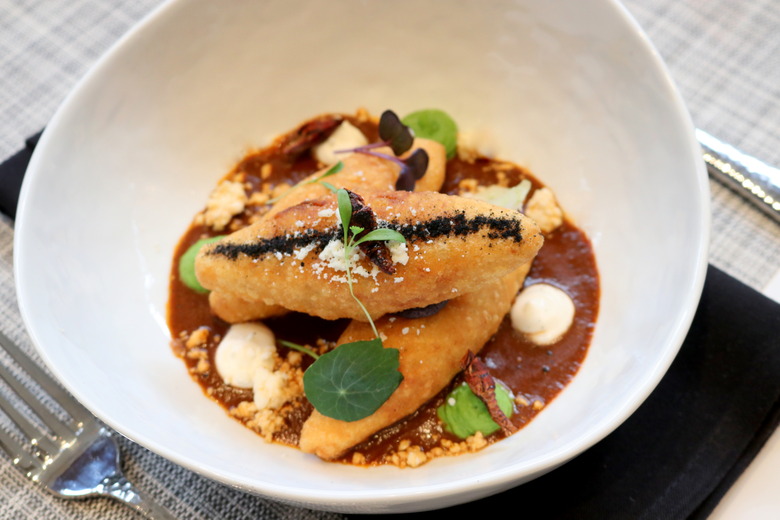Houston's Xochi Evokes The Culinary Traditions Of Oaxaca
As children, the Ortega brothers joined their family in leaving Mexico City to live for several years with their grandmother on a farm in the mountains of Puebla near the Oaxacan border. It was here that they learned a rural way of life – tending goats, farming peanuts and corn, raising cows – and the importance of growing and sourcing food. They also learned to make chocolate, cheese, nixtamal and masa for tortillas and tamales (all by hand) traditions they carry into their restaurant kitchens.
Now James Beard Award-winning chef Hugo Ortega and restaurateur Tracy Vaught, of H-Town Restaurant Group, teamed up to open Xochi in January 2017 on the ground floor of the Marriott Marquis Houston Downtown. Named after Xochitl, goddess of the flowers and ascribed with the meaning "to bloom or catch fire," is a creative endeavor of H-Town's culinary team of Ortega, executive pastry chef Ruben Ortega and beverage director/sommelier Sean Beck.
Xochi pinpoints the culinary, indigenous flavors of one state, Oaxaca, which, according to restaurant reps, is the "culinary capital of Mexico" because of its varied geographic regions, climate and terrain, and "preservation of primitive customs and recipes."
"We balance traditional coastal dishes with our own creations," says Vaught.
Within the state, each geographic region has a local food because residents tend to stay close due to its rugged, and some would say isolating, terrain. For this reason, some of the areas have preserved ancient customs and recipes. Fortunately, the fertile ground allows people to grow what they need.
"Oaxaca is so rich with culinary diversity and traditions and is a place I never tire of visiting," says Hugo Ortega. "Its large size and numerous geographic regions hold endless interest for me as a chef and as a Mexican native. Xochi is my tribute to Oaxaca and its culinary wealth."
Xochi's food team makes everything from scratch in-house, from cheeses including queso fresco and Oaxacan string cheese, nixtamal and tortillas, moles, fresh-ground spice blends, and house-roasted and -ground cacao beans for the house-made Mexican chocolate.
On a recent press trip, The Daily Meal was treating to a tasting that included Molotes de Xoxocotlan, oval masa cakes with potatoes, chorizo ismeño, avocado, chile de onza, and queso fresco; Cabrito con Chichilo, crispy goat with charred chilhuacle pepper mole; Ostiones de Lujo, wood-roasted oysters in mole amarillo; Callo de Hacha, scallop, xoconostle, cucumber, chile de arbol verde, lime; and Barbacoa de Res de Zaachila, skirt steak rolled with hoja santa, guajillo puya and costeño pepper broth, potato, carrots, and masa dumplings. Some herbs common to Oaxaca but not widely used outside the area appear on Xochi's menu: Sample poleo, pitiona, hierba de conejo, chepiche, chile de palo, cedron, and diente de león.
While Oaxaca is known as "the land of seven moles" after the main, classic moles, there are actually hundreds of different types made in the area. Xochi dedicates a section of the menu to mole, with rotating offerings, from classic mole negro to mole verde, mole de chicatana (ant mole), and estofado almendrado (tomato-almond mole). A mole sampler plate, served with fresh warm corn tortillas, is for those that want to try a few varieties in one sitting.
The menu also features a variety of meats, seafood and vegetables, many prepared in the horno, or wood-fired oven, such as Bistec con Mole de Chicatana, grilled prime Black Angus ribeye, seared black bean tamal, ant mole; Lechon, slow-cooked suckling pig, huaxmole, plantain molotes; Negro en Negro, Tejas Heritage Farm black-footed chicken with mole negro and creamy corn meloso; and Sopa de Piedra, a traditional fish and shrimp soup, heated with river rocks warmed in the horno.
And a variety of edible insects – delicacies in Mexico – are found throughout the menu, in dishes such as the Queso del Rancho – house-made queso de cincho with chicharrones a trio of insects (gusanos, chicatanas, chapulines) and guacamole; the mole de chicatana; and sal de gusano (gusano salt) made with dried gusanos worms used to salt the rims of some of the signature cocktails.
Among the signature dessert items is the Cacao, a realistic-looking cacao pod carved from white chocolate and sprayed with edible "paint" to mimic real pods, which are then filled with an array of chocolate items – all made with the house-made chocolate – of varying textures, including milk chocolate cloud, chocolate criollo soil, chocolate ice cream, chocolate mousse and tejate foam. It's closer to the regional cuisine than other foods Americans sometimes call Mexican.
